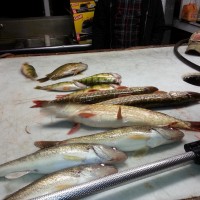DNR proposal: Reduce population of hammer-handle-sized northerns
• Article by: DOUG SMITH , Star Tribune
• Updated: February 11, 2015 – 11:30 AM
A DNR proposal would reduce their impact in what could be the biggest change to northern pike regulation in 50 years.
A DNR proposal would try to boost the size of northerns in Minnesota lakes by encouraging the taking of younger fish and discouraging the taking of older, larger fish. The state would be divided into three northern-pike management zones, each with separate fishing regulations. Right: Officials say the proposal would create more larger northerns, like this one, while also helping the populations of other fish types, such as walleyes. Officials emphasize that the effect of the proposal would take years to be felt.
The overabundance of small, hammer-handle-size northerns, which plagues many Minnesota lakes and annoys anglers, could be curtailed under a landmark proposal now being considered by the Department of Natural Resources.
If approved, it would be the biggest change to northern pike regulations in more than 65 years.
The new regulations would require anglers to release more medium-size northerns, so they could grow larger, and would encourage anglers to harvest more of those smaller northerns. But the trade-off, officials say, is that eventually anglers would catch more larger northerns, and likely more walleyes, perch and other fish, too, as the small-northern population declines.
“It’s not just for pike anglers — this will have broader effects on the fish community,’’ said Gary Barnard, DNR area fisheries manager in Bemidji.
The DNR’s proposal would eliminate the statewide northern bag limit of three fish, with one over 30 inches, and replace it with regulations that would differ depending on three new northern pike management zones: south, north-central and northeast. The biggest changes would occur in the north-central region — roughly north of Hwy. 55 and west of Hwy. 53 — where most of the lakes with an overabundance of small northerns are located.
There, the northern bag limit would be 10 fish under 22 inches, with two over 26 inches allowed in the 10-fish bag. All northerns 22 to 26 inches would have to be released.
“This is big,” said Henry Drewes, DNR regional fisheries manager in Bemidji. “This would be a paradigm shift in pike management.”
Officials say as those protected fish grow they would consume smaller northerns, helping balance the fisheries populations. And when they exceed 26 inches, anglers could harvest them.
Currently the northern harvest is dominated by small fish, he said.
While the focus is on boosting the quality of northern fishing by reducing the number of small northerns, the ramifications to other fish species are what excite Jim Lilienthal, 68, of rural Brainerd, a member of Anglers for Habitat and retired DNR fisheries biologist.
Last year, Lilienthal did his own study showing the devastating impact current northern regulations have on lakes stocked with walleyes in the north-central region. Of the 722 lakes stocked with walleyes, 52 percent have a clear overabundance of northerns, which hurts walleye populations, he said.
“It was frustrating for me to see how many lakes were absolutely infested with high densities of small pike,” he said. “Perch populations have been annihilated in some lakes, so you’re feeding those stocked walleye fingerlings to the pike.”
Last year, he called for major changes, similar to what the DNR is now proposing. In that key north-central zone, he would prefer regulations that would allow only one northern over 26 inches to be kept, not two, but otherwise he likes the proposal. In the northeast, there would be a two-fish bag limit, with none over 30 inches allowed. In the south, there would be a two-fish bag limit, with a 24-inch minimum size.
The DNR plans to hold public meetings and solicit comments this year before taking a proposal to the Legislature next year. Lilienthal said all anglers, not just those who want to catch bigger northerns, have a stake in the outcome.
“If walleye anglers, especially, don’t get involved, they are missing out,” he said. “Doing nothing has consequences for all anglers.”
The current statewide northern regulation does nothing to boost the quality of the northern fishery, Drewes said. “That’s why we’ve been using experimental and special regulations to improve some lakes,” he said.
But in 2011 the Legislature restricted the DNR from imposing those regulations on more than 100 lakes — a law that would have to be changed under the current proposal. Legislators imposed the 100-lake limit at the behest of the Minnesota Darkhouse and Angling Association, which feared the length restrictions used in experimental regulations limited a spearer’s ability to take northerns.
“We’re concerned all of the solutions are based on length, which can be problematic for spearers,” said Tim Spreck of the Darkhouse and Angling Association. “It cuts down on opportunities for sure.”
But Spreck said he was cautiously optimistic.
“The idea of removing the hammer-handle problem is intriguing enough to proceed with the process.”
Even if the proposal is approved and launched in 2016, officials say it will take several years or longer for the effects to be noticed.
But one thing is certain, DNR officials and Lilienthal say: If nothing is done, hammer-handle northerns will continue to dominate many lakes.
Doug Smith • 612-673-7667
